Bacteria are unicellular, prokaryotic organisms that are found everywhere, making them the most abundant living entities on Earth. They can thrive in extreme environments such as hot springs, snowy regions, and deep oceans, where other organisms find it difficult to survive.
Key Features of Bacteria:
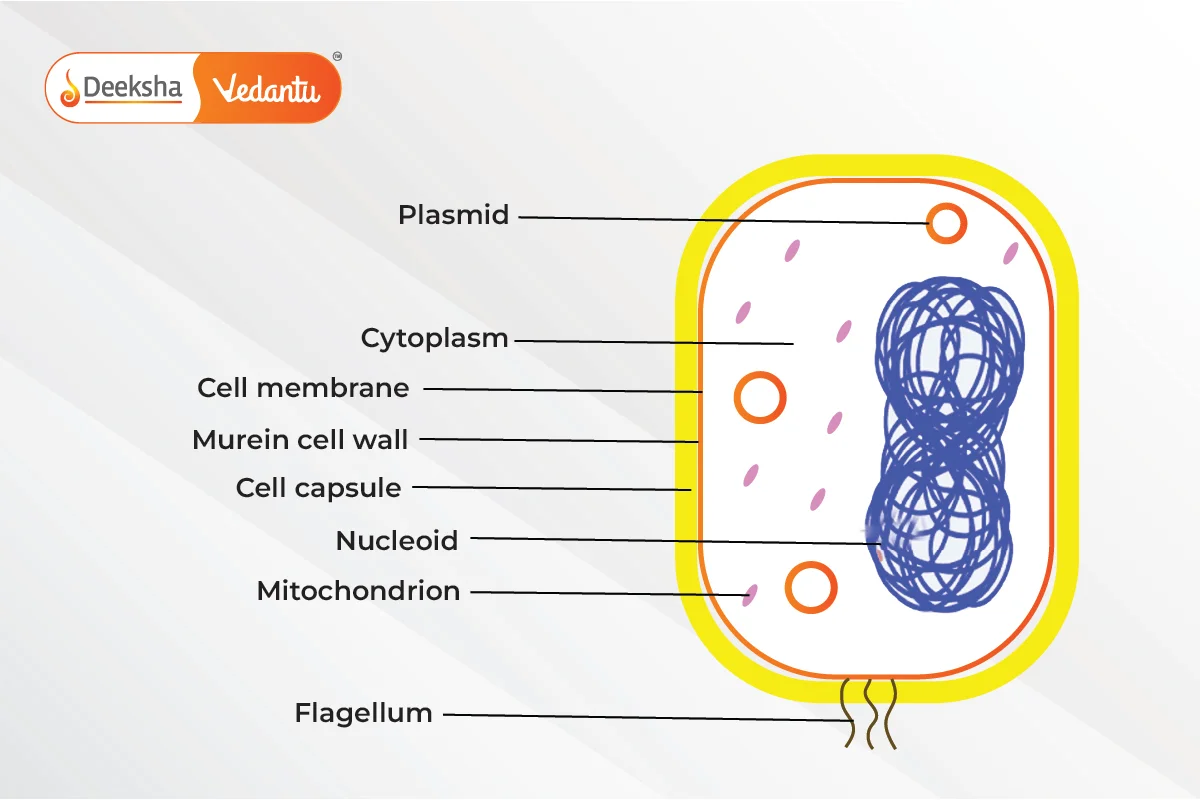
- Unicellular and prokaryotic.
- Various shapes, sizes, and arrangements.
- Lack of nucleus and membrane-bound organelles.
- DNA located in the cytoplasm, not packaged as in eukaryotic cells.
- Typically 10 times smaller than human cells, with a diameter of approximately 1µm (10^-6 m).
- Rigid cell wall made of peptidoglycan (murein), providing structural integrity.
- Shape is a characteristic feature of bacterial species.
- May have external appendages like cilia and flagella.
- Can be photoautotrophs, chemoautotrophs, or parasites.
Morphology of Bacteria
The shape of a bacterial cell is a distinguishing feature and a characteristic property of a species. This morphology impacts its pathogenicity, adaptability, and evolution. The cell wall, composed of peptidoglycan, plays a crucial role in determining the shape and structural integrity of bacteria.
Different Shapes of Bacteria:
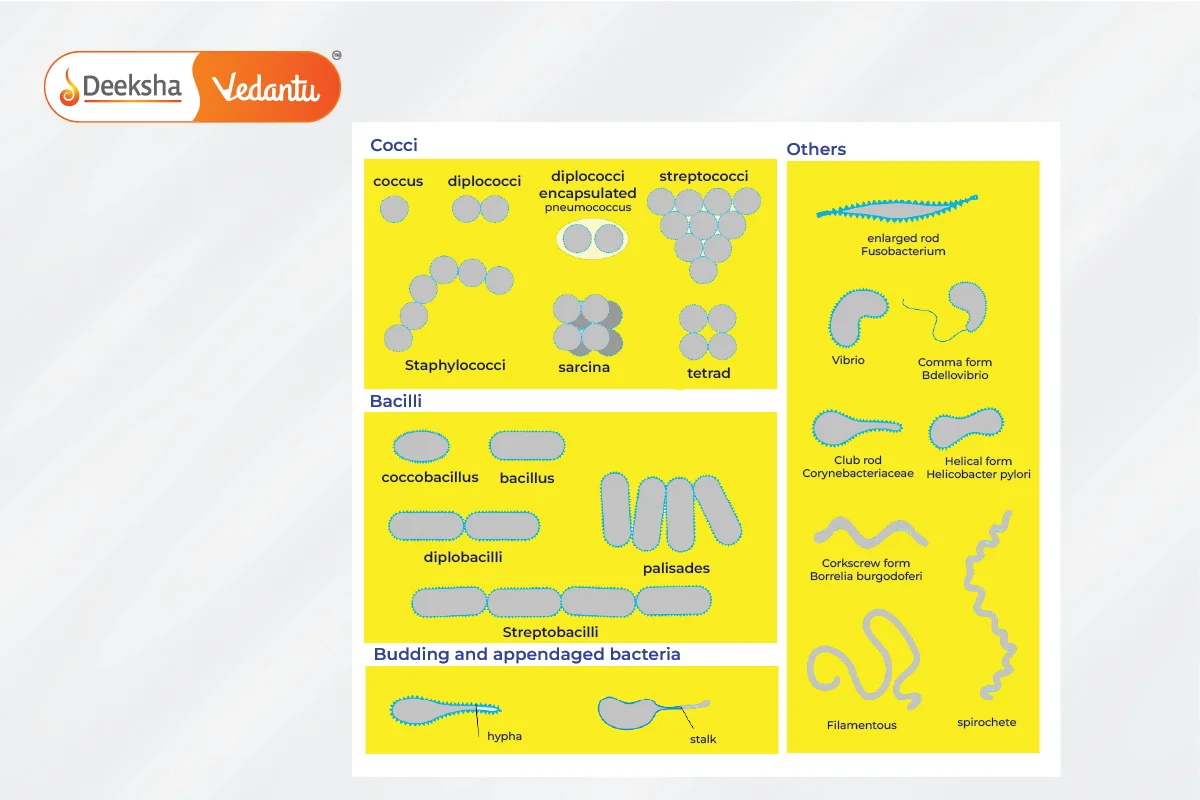
1. Spherical (Cocci):
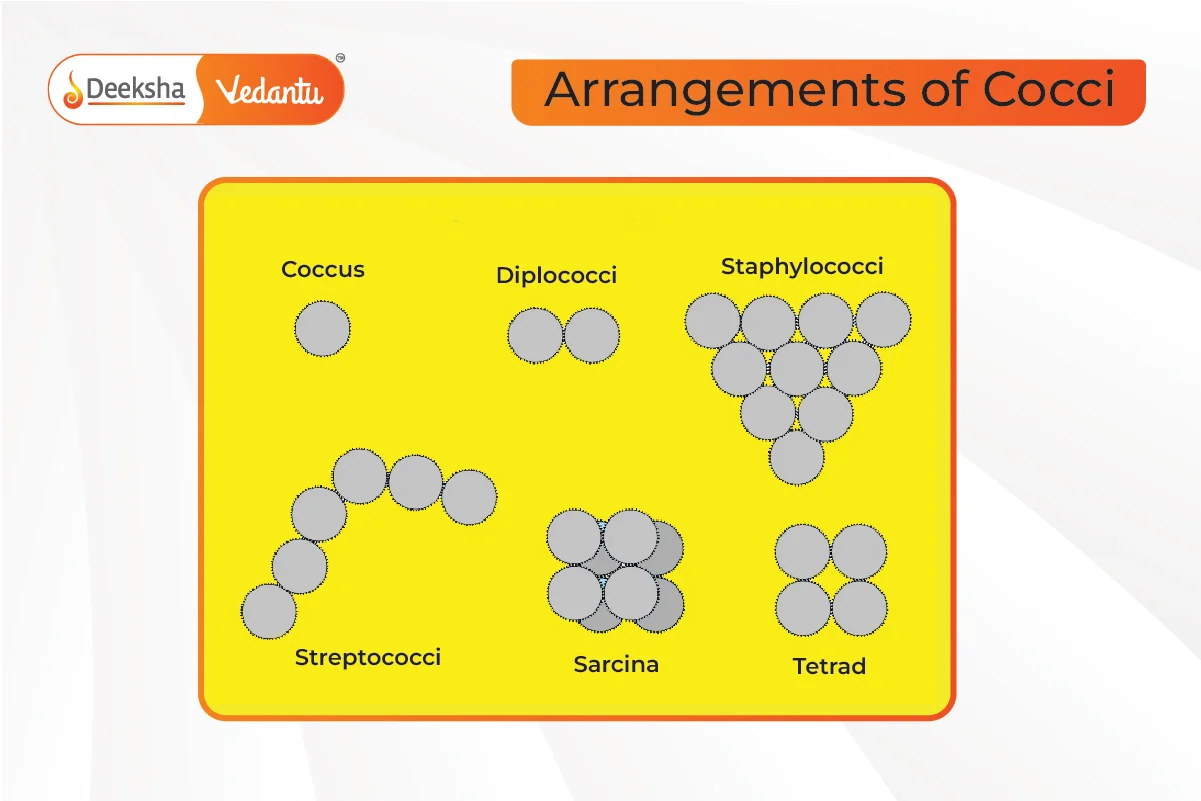
- Can be single or in groups (e.g., pairs, chains, clusters).
- Varies from round to oval or elongated shapes.
- Gram-positive with thick peptidoglycan layer or gram-negative with thin peptidoglycan layer.
- Subtypes based on arrangement:
- Monococcus: Single spherical cell.
- Diplococcus: Pair of cocci (e.g., Neisseria, Streptococcus pneumoniae).
- Streptococcus: Chain of cocci (e.g., Streptococcus mutans).
- Tetrads: Group of four cells (e.g., Micrococcus).
- Staphylococcus: Irregular clusters (e.g., Staphylococcus aureus).
- Sarcinae: Group of eight cells (e.g., Sarcina ventriculi).
2. Rod-shaped (Bacilli):
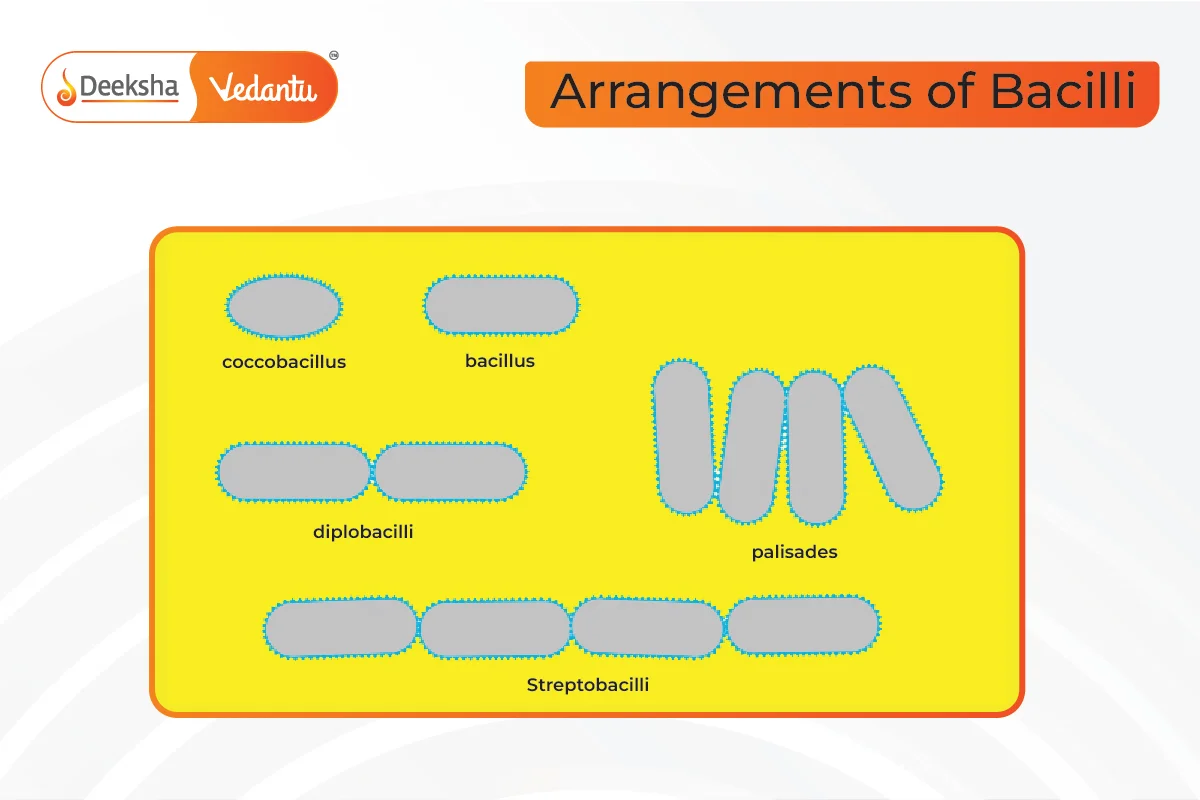
- Occur singly or in groups.
- Can be gram-positive (e.g., Bacillus) or gram-negative (e.g., Escherichia coli).
- Subtypes based on arrangement:
- Bacillus: Single rod-shaped cell.
- Diplobacilli: Pair of bacilli.
- Streptobacilli: Chain of bacilli.
- Coccobacilli: Short and oval-shaped, resembling cocci.
- Palisades: Bacilli arranged in a fence-like structure (e.g., Corynebacterium diphtheriae).
3. Spiral-shaped:
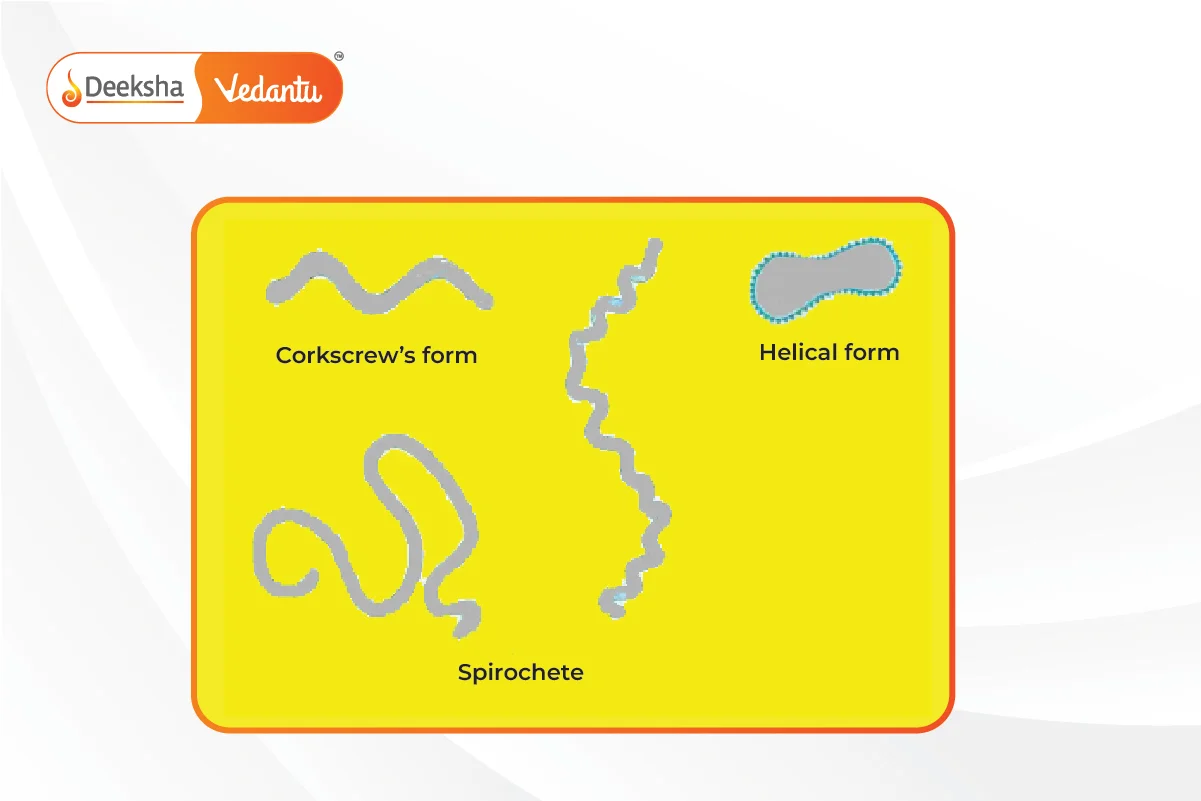
- Helical or spiral shape.
- Types based on thickness and motility:
- Spirillum: Rigid with external flagella (e.g., Spirillum, Helicobacter pylori).
- Spirochete: Thin, flexible with internal flagella (e.g., Treponema pallidum).
4. Comma-shaped (Vibrio):

- Curved, resembling a comma.
- Mostly gram-negative (e.g., Vibrio cholerae).
5. Other Shapes:
- Filamentous: Long filament-like structure (e.g., Candidatus savagella).
- Star-shaped: Resembling a star (e.g., Stella humosa).
- Rectangular: Box-shaped (e.g., Haloarcula vallismortis).
- Pleomorphic: Variable shape and size (e.g., Mycoplasma).
- Appendaged: With stalk-like structures (e.g., Caulobacter crescentus).
- Trichome: Chain of cells often in a slimy sheath (e.g., cyanobacteria).
- Lobed: Irregular lobed structure (e.g., Sulfolobus acidocaldarius).
- Fusiform: Spindle-shaped, bulging in the middle (e.g., Fusobacterium).
- Sheathed: Bacteria covered with a sheath (e.g., Leptothrix).
Conclusion
Understanding the shapes of bacteria is crucial for identifying different species and understanding their pathogenicity, adaptability, and evolutionary traits. This knowledge is essential for NEET aspirants to master the topic of bacterial morphology and its implications in biology.
FAQs
The shape of bacteria is a fundamental characteristic used in their classification and identification. Along with staining properties, metabolic activities, and genetic analysis, the shape helps microbiologists categorize bacteria into different genera and species, aiding in diagnosis and treatment of bacterial infections.
- Cocci: Streptococcus pneumoniae causes pneumonia.
- Bacilli: Bacillus anthracis causes anthrax.
- Spirilla: Helicobacter pylori causes stomach ulcers.
- Vibrio: Vibrio cholerae causes cholera
Spiral-shaped bacteria, such as spirilla and spirochetes, often have unique flagellar arrangements that allow them to move in corkscrew-like motions. This type of movement is efficient in viscous environments, helping them navigate through mucus and tissues.
Yes, some bacteria are pleomorphic, meaning they can change shape in response to environmental conditions, such as nutrient availability, temperature, and pressure. This ability allows them to adapt and survive in diverse environments.
The shape of bacteria is influenced by their genetic makeup, the structure of their cell wall, and their environmental adaptations. Rod-shaped bacteria (bacilli) often have an advantage in motility and surface attachment, while spherical bacteria (cocci) are more resistant to mechanical stress.
Different bacterial shapes contribute to their adaptability and evolutionary success. For example, the spiral shape of spirochetes allows them to move through viscous environments, while the compact shape of cocci helps them survive harsh conditions. The ability to change shape, as seen in pleomorphic bacteria, enhances their survival under varying environmental stresses.
Coccus-shaped bacteria are classified based on their arrangement as follows:
- Monococcus: Single spherical cell.
- Diplococcus: Pair of cocci.
- Streptococcus: Chain of cocci.
- Tetrads: Group of four cells.
- Staphylococcus: Irregular clusters.
- Sarcinae: Group of eight cells.
The bacterial cell wall, primarily composed of peptidoglycan, provides structural support and determines the shape of the bacteria. Variations in the composition and thickness of the peptidoglycan layer contribute to the different shapes and rigidity of the bacterial cell wall.
The shape of bacteria affects their motility, ability to adhere to surfaces, and how they interact with their environment. For instance, rod-shaped bacteria like Bacillus are often more motile due to their flagella, while spherical bacteria like Streptococcus are better at withstanding desiccation. Shape can also influence the effectiveness of antibiotics and the bacteria’s ability to evade the immune system.
The primary shapes of bacteria are spherical (cocci), rod-shaped (bacilli), spiral (spirilla and spirochetes), and comma-shaped (vibrio).
Related Topics
- Important Notes For NEET Biology – Anatomy of Flowering Plants
- Important Notes For NEET Biology – Breathing and Exchange of Gases
- What is Hemoglobin
- Important Notes For NEET Biology – Chromosome Structure
- Plant Hormones
- Paramecium
- Bryophytes
- Krebs Cycle
- Important Notes For NEET Biology – Cell Cycle and Cell Division
- Epithelial Tissue
- Plasmid
- Euglena
- Marchantia
- Important Notes For NEET Biology – The Living World
- Nostoc











Get Social